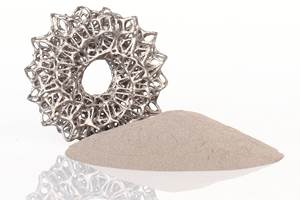IMPACT Project Call Worth $11.7M in Funding for Casting, Forging
The project call is for demonstrating productivity and yield benefits for casting and forging manufacturing via additive manufacturing technologies, execute techno-economic analysis for metal powder AM, and to bridge component sourcing gaps with AM parts for casting and forging applications.
The National Center for Defense Manufacturing and Machining (NCDMM) and America Makes have announced a new directed project call funded by the Office of the Under Secretary of Defense, Research and Engineering Manufacturing Technology Office (OUSD (R&E)) and the Air Force Research Laboratory (AFRL) worth a total of $11.7 million.
The objective of the “Improvements in Manufacturing Productivity via Additive Capabilities and Techno-Economic Analysis (IMPACT)” project call is to demonstrate productivity and yield benefits for casting and forging manufacturing via additive manufacturing (AM) technologies, execute techno-economic analysis for metal powder AM, and to bridge component sourcing gaps with AM parts for casting and forging applications. The project call is also seeking innovative solutions for robotic AM process planning for continuous fiber-reinforced composite structures.
AM is of significant interest to the U.S. manufacturing base as the technology enables shorter lead times, mass customization, energy reduction, complex shapes and production of parts on demand providing benefits to both new acquisitions and legacy systems. “This project call addresses the needs of a broad cross section of our nation’s supply chain, including the casting and forging supply chain,” says Brandon Ribic, Ph.D., America Makes technology director. “We are thrilled for the opportunity to deliver longer term strategic investments to scaling AM technologies.”
America Makes strives to accelerate the development and deployment of innovative, cost-effective, energy-efficient AM and 3D printed technologies to meet defense and/or commercial needs. The proposed projects should be applicable to Technology Readiness Level (TRL) 4-7 and Manufacturing Readiness Level (MRL) 4-7 at the onset of the proposed project.
The request for proposal (RFP) includes 10 topic areas of focus. The number of anticipated awards and maximum funding will vary depending on the topic area being addressed.
Demonstrating Lead Time, Productivity and Yield Improvements for Casting and Forging Manufacturing Operations Using AM Technologies
- Topic Area 1 - Develop/disseminate leading practices and accelerate the adoption of 3D-printed molds/cores for sand castings.
- Topic Area 2 - Mature AM ceramic technology and promote adoption for rapid, low- volume production of investment castings for defense applications.
- Topic Area 3 - Develop and disseminate tools/frameworks to improve die (die casting) life with AM printed cooling channels.
- Topic Area 4 - Mature and promote methods to add high wear layers and complex geometric features to forgings.
- Topic Area 5 - Pilot the industrialization of AM preforms to expedite the forging process for low-volume forged components.
- Topic Area 6 - Develop and disseminate leading DED and cold spray practices to promote the adoption of die repair for forging applications.
- Topic Area 7 - AM for casting and forging innovations relevant to DoD acquisition or sustainment programs.
Disseminating the Value Proposition of Bridging Component Sourcing Gaps with AM Parts for Critical Casting and Forging Production
- Topic Area 8 - Techno-economic analysis and manufacturing readiness assessments to address bridging component sourcing gaps with AM parts for critical casting and forging production.
Identifying and Disseminating the Impact of Strategic R&D to Scale Powder Bed AM Technology
- Topic Area 9 - Powder AM techno-economic analysis.
Advancing AM Processing for Continuous Fiber Reinforced Composites
- Topic Area 10 - Innovations in robotic AM process planning.
To be eligible, the deadline for lead proposer to complete fully executed membership agreement with America Makes for Topics 1-8 is due by Wednesday, June 14; and for Topics 9-10 by Friday, June 23. Submission deadlines are Wednesday, June 28 by 5 p.m. ET for Topics 1-8; and Friday, July 7 by 5 p.m. ET for Topics 9-10. For full details and guidelines, visit Project Call For Applied Research Projects – May 2023.
Related Content
7 Takeaways From America Makes MMX 2023
America Makes just held its recent Members Meeting & Exchange. Here are observations related to cost and collaboration; digital manufacturing; and the sustainment and supply chain needs of the DoD.
Read MoreDefense Department Looks to Additive Manufacturing to Propel Hypersonic Systems
The DoD is requesting prototype solutions for its Growing Additive Manufacturing Maturity for Airbreathing Hypersonics (GAMMA-H) challenge as part of the department’s ongoing efforts to expand manufacturing processes for intricate hypersonic weapons parts.
Read MoreNew Zeda Additive Manufacturing Factory in Ohio Will Serve Medical, Military and Aerospace Production
Site providing laser powder bed fusion as well as machining and other postprocessing will open in late 2023, and will employ over 100. Chief technology officer Greg Morris sees economic and personnel advantages of serving different markets from a single AM facility.
Read MoreAmerica Makes Announces Winners for IMPACT Project Call
The project call focuses on additive manufacturing research related to casting and forging, metal powder sourcing and robotic AM process planning for continuous fiber-reinforced composite structures.
Read MoreRead Next
3D Printing Brings Sustainability, Accessibility to Glass Manufacturing
Australian startup Maple Glass Printing has developed a process for extruding glass into artwork, lab implements and architectural elements. Along the way, the company has also found more efficient ways of recycling this material.
Read MoreAt General Atomics, Do Unmanned Aerial Systems Reveal the Future of Aircraft Manufacturing?
The maker of the Predator and SkyGuardian remote aircraft can implement additive manufacturing more rapidly and widely than the makers of other types of planes. The role of 3D printing in current and future UAS components hints at how far AM can go to save cost and time in aircraft production and design.
Read MoreHybrid Additive Manufacturing Machine Tools Continue to Make Gains (Includes Video)
The hybrid machine tool is an idea that continues to advance. Two important developments of recent years expand the possibilities for this platform.
Read More






















